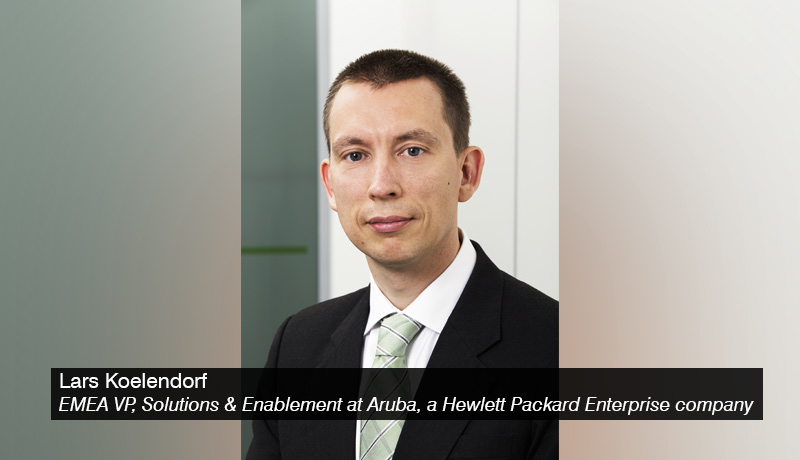
By: Lars Koelendorf, EMEA Vice President, Solutions & Enablement at Aruba, a Hewlett Packard Enterprise company
An unprecedented ability to connect, collaborate and work from anywhere. Enterprise-level connectivity and equipment at home. New work spaces, automated systems and cognizant buildings at the office. The hybrid workplace, with all its incredible features and possibilities, is undoubtedly something to look forward to.
But mixed with this excitement must alsobe apprehension. This new model cannot function without fast, reliable wireless connectivity and a unified, automated and secure network. And for most organizations, this will mean investing in their IT infrastructure.
Given the current economic circumstances and ongoing unpredictability of what comes next, it’s understandable that organizations may feel that they will struggle to finance these investments, or that they are simply not in a position to consider any upgrades beyond what’s immediately necessary for the return to the office.
The good news, however, is that with a few smart, strategic moves, I firmly believeit is possible for organizations to leverage their current budgets and resources to create a network that delivers both short- and long-term value. Here’s what you need to think about to put these moves into motion.
The enterprise data that is available today has tremendous potential to deliver significant cost savings – but it must first be turned into actionable insights. That’s why organizations need to prioritize network investments that will improve their ability to analyze the data at their disposal.
This means investing in Edge technologies. Not only are organizations dealing with unprecedented amounts of data, that data is increasingly being generated outside of the traditional data centres. Instead, it is being created by user devices and IoT sensors at the Edge of the network – the place people, devices, and things connect to the digital world.
Processing data at the Edge is the only way to reduce latency, minimize transmission costs and unleash its full potential for optimization and innovation. The ability to unlock and leverage their data in real-time will enable organizations to take actions that deliver long-lasting benefits, such as improved operational efficiency and costs, opportunities for greater profitability, and new revenue streams.
At a time when resources and budgets are tight and yet change is more pervasive than ever, organizations need to choose solutions that offer simple pay-as-you-go subscriptions, and financial and consumption flexibility across hardware, software, and management operations.
These solutions, which turn infrastructure expenses from CapEx investments into OpEx costs, represent benefits for both cost-efficiency and business agility. They ensure that payments can be aligned to budgets, revenue and cash flow – making them suitable for whatever the financial situation is at any given moment. They also provide the freedom to test, adapt, build and possibly rebuild without the fear of exhausting already strained budgets, as you’ll only ever pay for what you’re currently using.
Essentially, they are the foundations of a bespoke, flexible, and scalable network that can adapt rapidly to changing needs and circumstances.
Adopting more environmentally friendly practices and leveraging existing equipment and systems has the double benefit of helping organizations maximize their budgets while also meeting their sustainability goals – something that we know is becoming more and more important across all industries.
Through the Circular Economy, which aims to extend the utility and value of resources and eliminate waste, organizations can optimize and repurpose IT assets like network equipment, PCs, laptops, servers and storage devices.
Or they can convert them into capital that funds innovation and transformation initiatives. By remarketing and reselling any unneeded equipment, organizations can return significant amounts of money to their IT budgets.
They should also avoid buying new hardware unless absolutely necessary. When it comes to expanding infrastructure and making new investments, adapting pre-owned equipment or choosing functionally equivalent used hardware can have dramatic cost savings.
Additionally, organizations can increase the likelihood of further savings down the road by strategically choosing technology that is designed for energy efficiency, and easy recycling and removal of heavy metals for reuse.
Similarly, organizations can also rent new equipment instead of buying it outright. With vendors like Aruba offering a technology refresh as part of the monthly contract, this ensures organizations stay on the latest technology for the same price. And when upgrades happen, the vendor takes the existing equipment and uses it elsewhere – maintaining the circular economy.
The reality is that a network that can support the hybrid workplace and business agility is becoming an increasingly urgent need.
We have now seen that a hybrid workplace model is the answer to the changes in how we communicate, live and work – changes that have only been accelerated by COVID-19. The mission-critical role of IT within this model means that organizations cannot afford the consequences of a poor performing network.
Organizations must invest in their IT infrastructure or risk limiting productivity, creating security threats, frustrating employees and clients, and losing their competitive advantage. At scale and over time, these issues pose a severe threat to business continuity.
I hope that the strategies above will enable you to make these investments in a way that suits your organization’s budget and resources. I also hope that they will help you see beyond the challenges and stay enthusiastic about hybrid workplaces. We are entering a brand new era of work and I, for one, cannot wait to see what it will bring.